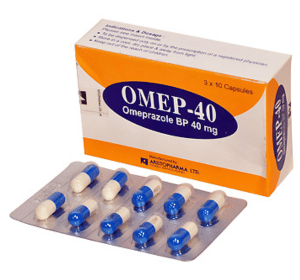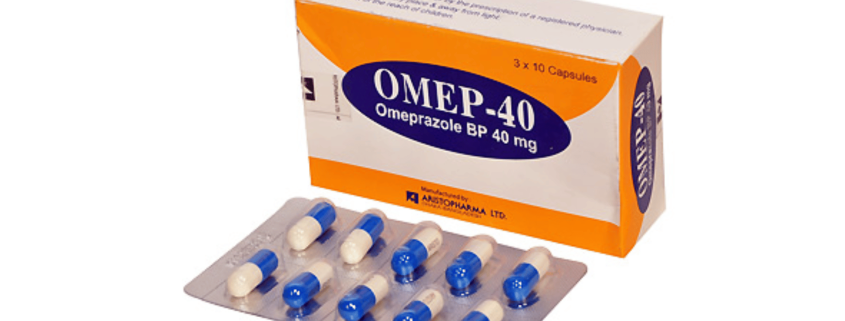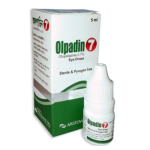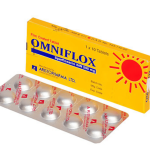Omep (Omeprazole)

Therapeutic Group : Antiulcerant
Presentation:
Omep-10 Capsule Each capsule contains Omeprazole BP 10 mg as enteric-coated pellets.
Omep-20 Capsule Each capsule contains Omeprazole BP 20 mg as enteric-coated pellets.
Omep-40 Capsule Each capsule contains Omeprazole BP 40 mg as enteric-coated pellets.
Omep IV Injection Each vial contains lyophilized Omeprazole Sodium BP equivalent to Omeprazole 40 mg.
Indications:
Omep Capsule:
Omep is indicated for short and long term treatment of duodenal ulcer, gastric ulcer, resistant ulcer, NSAIDs-induced peptic ulcer and gastroduodenal erosions, erosive reflux esophagitis, refractory reflux esophagitis, acid reflux disease, acid related dyspepsia, Zollinger-Ellison syndrome.
Omep IV Injection:
Prophylaxis of acid aspiration.
Treatment in patients where oral therapy is inappropriate e.g. in severely ill patients with reflux esophagitis, duodenal ulcer, gastric ulcer etc.
Zollinger-Ellison syndrome.
Dosage & Administration:
Omep Capsule:
Omep capsule should be taken before meal.
Duodenal ulcer : 20 mg once daily for 4 weeks. In severe cases 40 mg once daily for 4 weeks.
Gastric ulcer : 20 mg once daily for 8 weeks. In severe cases 40 mg once daily for 8 weeks.
Resistant ulcer : 40 mg daily for 4 weeks. For long term therapy the maintenance dose is 40 mg daily.
Maintenance of recurrent duodenal ulcer : 20 mg once daily.
NSAIDs induced peptic ulcer and gastroduodenal erosions : 20 mg once daily for 4 weeks, followed by a further 4 weeks if not fully healed. Prophylaxis in patients with a history of NSAIDs associated gastroduodenal lesions that require continued NSAIDs treatment, 20 mg once daily.
Gastro Esophageal Reflux Disease (GERD) : Adult: 20 mg once daily for 4 weeks, continued for further 4-8 weeks if not fully healed. Children aged 1-16 years: Body weight 10 Kg to <20 Kg: 10 mg once daily for 4-8 weeks & 20 Kg: 20 mg once daily for 4-8 weeks.
Refractory reflux esophagitis : 40 mg once daily for 8 weeks, may be continued at 20 mg once daily.
Acid reflux disease : For long term management, 10 mg daily, increasing to 20 mg once daily if symptoms return.
Acid related dyspepsia : 10-20 mg once daily for 2-4 weeks according to response.
Zollinger-Ellision Syndrome : 60 mg once daily adjusted individually and continued as long as necessary. Most patients will be effectively controlled with 20-120 mg daily. Dosage above 80 mg should be divided and given twice daily.
Omep IV Injection:
| Indication | Dose |
|---|---|
| Prophylaxis of acid aspiration | 40 mg 1 hour before surgery |
| Treatment in patients where oral therapy is inappropriate e.g. in severely ill patients with reflux esophagitis, duodenal ulcer, gastric ulcer etc. | 40 mg once daily |
| Zollinger-Ellison Syndrome | Recommended initial dose is 60 mg daily. Higher daily doses may be required and the dose should be adjusted individually. When doses exceed 60 mg daily, the dose should be divided and given twice daily. |
Method of administration:
Injection:
Omeprazole IV injection is obtained by adding 10 ml Sodium Chloride 0.9% to the vial containing powder. After reconstitution the injection should be given slowly over a period of at least 2.5 minutes as a maximum rate of 4 ml per minute. The reconstituted IV injection should be used within 4 hours if stored at room temperature.
Infusion :
The content of vial must be dissolved in 100 ml Sodium Chloride 0.9% injection for infusion or 100 ml 5% dextrose injection. The reconstituted solution should be used within 12 hours when omeprazole is dissolved in Sodium Chloride 0.9% injection and within 6 hours when dissolved in 5% dextrose. The reconstituted solution should not be mixed or co-administered in the same infusion set with any other drug. Omep IV infusion should be given as an intravenous infusion over a period of 20-30 minutes or more.
Warning & Precautions:
Impaired renal function : In such cases, dosage adjustment is not required.
Impaired hepatic function : As bioavailability and half-life is increased in patient with impaired hepatic function, the dose requires adjustment with a maximum daily dose of 20 mg.
The elderly : Dosage adjustment is not required in the elderly.
Side effects:
Omep is generally well tolerated. Nausea, diarrhoea, flatulence, abdominal pain, constipation, dizziness and headache have been stated to be generally mild and transient and not requiring a reduction in dosage.
Drug interaction:
Omeprazole can delay the elimination of diazepam, phenytoin and warfarin. There is no evidence of an interaction with theophylline, propranolol or antacid.
Use in special groups:
Use in pregnancy: There is no adequate and well controlled studies on the use of Omeprazole in pregnant women. However, some studies show that it does not cause any harm to the foetus. Omeprazole should be used during pregnancy only if the potential benefit to pregnant women justifies the potential risk to the foetus.
Use in lactation : A decision should be taken to discontinue nursing or to discontinue the drug, taking into account the importance of the drug to the mother.
Paediatric use : Children over 1 year are recommended to use oral Omeprazole.
Packing:
Omep-10 Capsule: Box containing 48\\\\\\\\\\\\\\\’s capsules in alu-alu blister pack.
Omep-20 Capsule: Box containing 100\\\\\\\\\\\\\\\’s capsules in alu-alu blister pack.
Omep-40 Capsule: Box containing 30\\\\\\\\\\\\\\\’s capsules in blister pack.
Omep IV Injection: Each box contains one vial of lyophilize Omeprazole Sodium powder with 1 ampoule of 10 ml Sodium Chloride 0.9% Injection, 10 ml disposable syringe, bandage and alcohol pad.



